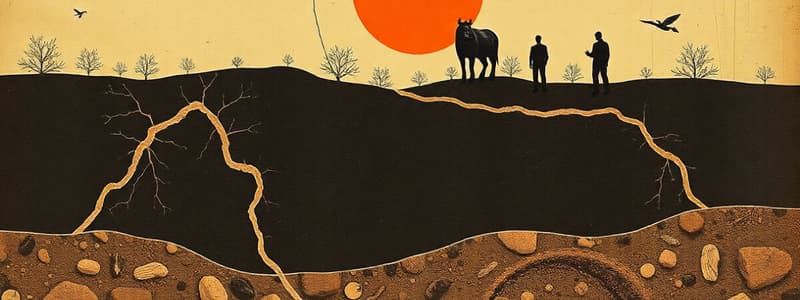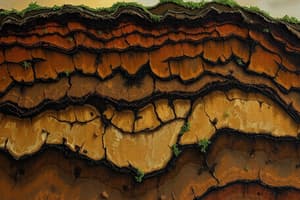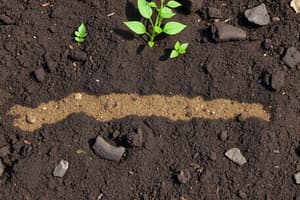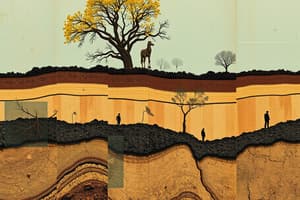Podcast
Questions and Answers
How does soil formation differ from soil development?
How does soil formation differ from soil development?
- Soil formation focuses on the physical aspects of soil, while soil development considers only the chemical changes.
- Soil formation is about the accumulation of organic matter, whereas soil development is about the translocation of organisms.
- Soil formation involves the processes of leaching only, while soil development concerns mineral weathering only.
- Soil formation specifically refers to the creation of soil from unconsolidated parent material, while soil development involves changes to the soil profile through natural processes. (correct)
Which of the following factors, as described by Hans Jenny, directly influences the chemical composition of soil?
Which of the following factors, as described by Hans Jenny, directly influences the chemical composition of soil?
- Parent material (correct)
- Climate
- Biotic factors (vegetation and animals)
- Topography
According to the concept presented, how do climate, living organisms, and topography interact with parent material over time to form soil?
According to the concept presented, how do climate, living organisms, and topography interact with parent material over time to form soil?
- They independently determine soil characteristics without affecting each other.
- They act together on the parent material over a period of time. (correct)
- They compete with each other to transform the parent material into soil.
- They alter the parent material instantly, and then time has no effect.
Which type of parent material is specifically transported and deposited by wind?
Which type of parent material is specifically transported and deposited by wind?
How do temperature changes contribute to the mechanical weathering of rocks?
How do temperature changes contribute to the mechanical weathering of rocks?
What role does rainfall play in the context of weathering and organic matter production?
What role does rainfall play in the context of weathering and organic matter production?
How does the topography or relief of an area influence soil formation?
How does the topography or relief of an area influence soil formation?
What does the study of soil genesis primarily focus on?
What does the study of soil genesis primarily focus on?
Which of the following best describes the process of weathering?
Which of the following best describes the process of weathering?
Why is weathering considered an important process in soil formation?
Why is weathering considered an important process in soil formation?
What is the initial geological material involved in weathering processes?
What is the initial geological material involved in weathering processes?
Which mechanical or physical process significantly contributes to weathering by causing expansion and contraction of rocks?
Which mechanical or physical process significantly contributes to weathering by causing expansion and contraction of rocks?
How does hydrolysis contribute to chemical weathering?
How does hydrolysis contribute to chemical weathering?
How does oxidation-reduction contribute to chemical weathering?
How does oxidation-reduction contribute to chemical weathering?
What distinguishes a soil horizon from a soil profile?
What distinguishes a soil horizon from a soil profile?
Which horizon is typically characterized by a dark color due to the accumulation of decomposed organic matter and is often referred as the plow layer in cultivated fields?
Which horizon is typically characterized by a dark color due to the accumulation of decomposed organic matter and is often referred as the plow layer in cultivated fields?
In which soil horizon does maximum removal or leaching occur, resulting in a light colored and sandy appearance?
In which soil horizon does maximum removal or leaching occur, resulting in a light colored and sandy appearance?
Which of the following processes is NOT directly involved in soil horizon differentiation?
Which of the following processes is NOT directly involved in soil horizon differentiation?
What contributes to the 'Addition to Soil' process in horizon differentiation?
What contributes to the 'Addition to Soil' process in horizon differentiation?
Which action contributes to 'Losses from the Soil' in horizon differentiation?
Which action contributes to 'Losses from the Soil' in horizon differentiation?
How is 'Translocation within the Soil' characterized in horizon differentiation?
How is 'Translocation within the Soil' characterized in horizon differentiation?
Which of the following is an example of 'Transformations within the soil'?
Which of the following is an example of 'Transformations within the soil'?
What is the significance of studying a soil pedon in soil science?
What is the significance of studying a soil pedon in soil science?
What is a key characteristic of polypedons, especially in relation to soil series classification?
What is a key characteristic of polypedons, especially in relation to soil series classification?
What defines diagnostic horizons in soil classification?
What defines diagnostic horizons in soil classification?
How do epipedons differ from subsurface diagnostic horizons?
How do epipedons differ from subsurface diagnostic horizons?
Which diagnostic horizon is characterized by being thick, dark-colored, and having good structure?
Which diagnostic horizon is characterized by being thick, dark-colored, and having good structure?
What is the distinguishing characteristic of a Histic (O) horizon?
What is the distinguishing characteristic of a Histic (O) horizon?
Which diagnostic horizon is known for its silicate clay accumulation?
Which diagnostic horizon is known for its silicate clay accumulation?
Flashcards
What is Soil Formation?
What is Soil Formation?
The formation of soil with reference to processes and soil-forming factors from unconsolidated parent material.
What is Soil Development?
What is Soil Development?
Changes in the soil profile caused by leaching, translocation of colloids, and accumulation of organic matter.
What is Parent Material?
What is Parent Material?
Texture, structure, and chemical composition of the original source material.
What is Residual/Sedentary Parent Material?
What is Residual/Sedentary Parent Material?
Signup and view all the flashcards
What is Alluvial parent material?
What is Alluvial parent material?
Signup and view all the flashcards
What is Colluvial parent material?
What is Colluvial parent material?
Signup and view all the flashcards
What is Aeolian parent material?
What is Aeolian parent material?
Signup and view all the flashcards
What is Lacustrine parent material?
What is Lacustrine parent material?
Signup and view all the flashcards
What is Marine parent material?
What is Marine parent material?
Signup and view all the flashcards
What are Climate and Living Organisms?
What are Climate and Living Organisms?
Signup and view all the flashcards
What is the effect of Temperature on rocks?
What is the effect of Temperature on rocks?
Signup and view all the flashcards
What is Soil Genesis?
What is Soil Genesis?
Signup and view all the flashcards
What is Weathering?
What is Weathering?
Signup and view all the flashcards
What is Mechanical/Physical weathering?
What is Mechanical/Physical weathering?
Signup and view all the flashcards
What is Hydrolysis?
What is Hydrolysis?
Signup and view all the flashcards
What is Hydration?
What is Hydration?
Signup and view all the flashcards
What is Oxidation?
What is Oxidation?
Signup and view all the flashcards
What is Soil Development?
What is Soil Development?
Signup and view all the flashcards
What is Soil Profile?
What is Soil Profile?
Signup and view all the flashcards
What is the O Horizon?
What is the O Horizon?
Signup and view all the flashcards
What is the A Horizon?
What is the A Horizon?
Signup and view all the flashcards
What is the E Horizon?
What is the E Horizon?
Signup and view all the flashcards
What is the B Horizon?
What is the B Horizon?
Signup and view all the flashcards
What is the C Horizon?
What is the C Horizon?
Signup and view all the flashcards
What is the R Horizon?
What is the R Horizon?
Signup and view all the flashcards
What are processes for horizon differentiation?
What are processes for horizon differentiation?
Signup and view all the flashcards
What are soil additions?
What are soil additions?
Signup and view all the flashcards
What are soil translocations?
What are soil translocations?
Signup and view all the flashcards
What are soil losses?
What are soil losses?
Signup and view all the flashcards
What is a Pedon?
What is a Pedon?
Signup and view all the flashcards
Study Notes
- Soil formation and soil development are different processes.
- Soil formation refers to the creation of soil, specifically the factors and processes of formation from unconsolidated parent material.
- Soil development refers to the changes in the soil profile because of leaching, translocation of colloids, accumulation of organic matter, and continued rock and mineral weathering.
- Hans Jenny determined the five factors that control the formation of soils:
- Parent material
- Climate
- Topography/relief
- Biotic (vegetation and animals) factor or living organisms
- Time
- The relationship of all the factors is: Soil = f (parent material) [p], climate [c], relief/topography [r], living organisms[l], time[t] or Soil = f (clorpt)
Parent Material
- Parent material determines both the mineralogy and the nutrition status of the soil.
- There are two categories of parent materials:
- Residual/sedentary: Rocks and minerals that are original to a location that gave rise to soil via physical and chemical processes.
- Transported:
- Alluvial: Transported by rivers.
- Colluvial: Transported by gravitational action.
- Aeolian: Wind deposits.
- Lacustrine: Lake deposits.
- Marine: Sea or ocean bottom deposits.
Climate and Living Organisms
- Climate and living organisms are the active factors that determine the degree and rate of soil formation.
- The most important climatic parameters are temperature and precipitation.
- Temperature changes cause expansion and contraction that can crack hard rock.
- Temperature directly affects the amount of organic matter produced.
- Organic matter production increases as temperature increases, provided there is rainfall for adequate plant growth.
- Rainfall affects weathering and the amount of organic matter production and decomposition.
- As rainfall increases, the possibility of erosion losses increases.
- When rainfall increases, organic matter production increases provided the temperature is high enough for plant growth.
Topography
- Topography, or relief, of the location of the parent material influences the effect of the active factors.
- Soil formation is less extensive in steep slopes where soil disturbance (erosion) and the degree of downward water flow are low.
Soil Genesis
- The study of soil formation is called soil genesis.
- Understanding soil genesis requires knowledge of the beginning of soil to interpret soils for specific uses.
Weathering
- Weathering is a chemical, physical, and biological process that results in the degradation of parent material and subsequent soil formation.
- It refers to the breakdown and changes in rocks and sediments at or near the Earth's surface by biological, chemical, and physical agents.
- Secondary minerals, like clay minerals, are synthesized during weathering.
- Weathering produces unconsolidated material (parent material) from which new soil is formed, provides plant nutrients, and results in the formation of secondary minerals.
- Rocks are the starting point for the weathering processes.
Basic Processes of Weathering
- Mechanical/Physical Process:
- Temperature changes (expansion and contraction and the freezing and thawing of water).
- Wind effects.
- Force exerted by plant roots.
- Chemical Process
- Hydrolysis: The breakdown of rock by acidic water to produce clay and soluble salts.
- Hydration: The chemical bonds of a mineral change as it interacts with water.
- Acid solution: Carbonic acid flows through cracks in rocks, causing some of the rock to dissolve.
- Oxidation-reduction:
- Oxidation: Process of oxidation rock breakdown occurs due to the disturbance caused by the addition of oxygen.
- Reduction: When oxidized minerals are placed in an environment where oxygen is absent, reduction takes place.
- Dissolution: Slightly acidic solutions on rocks create pits and holes and can act to enlarge and widen preexisting fractures.
Soil Development
- Soils are variable from one location to another, having different physical appearances and properties.
- These properties are a result of the chemical and physical processes of the environment.
Soil Horizon
- Soil horizon is a layer of soil roughly parallel to the land surface that differs from adjacent genetically related layers in physical, chemical, and biological properties.
- Soil Profile: A vertical section of soil through all of its horizons, extending into parent material.
Master Horizons
- O: Organic material at the surface, such as leaves, twigs, branches, and dead grass. Usually seen in forested soils and wetlands.
- A: The horizon where decomposed organic matter accumulates. It has a dark color and the area where most biological activity takes place. If the field is plowed this horizon extends to the depth of cultivation and becomes the plow layer.
- E: The zone of maximum removal or leaching, also eluviation. Maximum clay and chemical losses occur here, and is generally light-colored.
- B: Horizon where materials from the A and E horizons collect. Known as the zone of eluviation, containing maximum level of clay and chemicals.
- C: Layer of nearly unaltered mineral material; contains no biological activity and no eluviation. Considered the lower limit of the soil and called the soil's parent material.
- R: The underlying bedrocks, such as limestone, sandstone, or granite.
Processes Involved in Horizon Differentiation:
- Addition to soil
- Losses from the soil
- Translocation within the soil
- Transformations within the soil
Additions
- Water as precipitation, condensation, or runoff
- O2 and CO2 from the atmosphere
- N, Cl, and Sulfur from the atmosphere and precipitation
- Organic matter from biotic activities
- Materials from sediments
- Energy from the sun
Losses
- Water by evapotranspiration
- N by denitrification
- C as CO2 from oxidation of organic matter
- Soil by erosion
- Energy by radiation
- Water and material in solution or suspension
Translocations
- Clay, organic matter, iron oxides, and chemicals by water
- Nutrients circulated by plants
- Soluble salts in water
- Soils by animals
Transformations
- Decomposition of organic matter
- Reduced particle size by weathering
- Mineral transformations (primary to secondary)
- Clay and organic matter reactions
Soil Pedon
- Soil profiles do not give any information on irregularities in horizon thickness.
- A soil pedon is a three-dimensional soil body that represents the smallest volume, generally 1 to 10 meters across and hexagonal in shape.
- Polypedons are put together into groups known as soil series.
- There are over 14,000 soil series throughout the world, each with its own chemical and physical properties that affect management.
Diagnostic Horizons
- Are active in certain types of soil development and have specific soil characteristics indicative of certain classes of soils.
- Epipedons: Diagnostic horizons that occur at the surface.
- Diagnostic Subsurface Horizon: Diagnostic horizons below the surface.
Common Diagnostic Horizons
- Mollic horizon (A): Thick, dark-colored, good structure.
- Histic (O): Very high in organic matter content, wet during some part of the year.
- Oa: Most highly decomposed organic matter; very few fibers are identifiable.
- Oe: Intermediate degree of decomposition.
- Oi: Least degree of decomposition, with readily identifiable fibers.
- Argillic horizon (Bt): Silicate clay accumulation.
- Albic Horizon (E): Light colored; clay, Fe, and Al oxides most likely removed.
- Oxic Horizon (Bo): Highly weathered; primary mixture of Fe or Al oxide, rust-colored.
- Spodic Horizon (Bh): Organic matter, Fe and Al oxide accumulation.
- Calcic Horizon (Bk): Accumulation of CaCO3 or CaMgCO3.
- Duripan (Bqm): Hardpan, strongly cemented by silica.
- Fragipan (Bx): Brittle pan, usually loamy textured, dense.
Studying That Suits You
Use AI to generate personalized quizzes and flashcards to suit your learning preferences.




